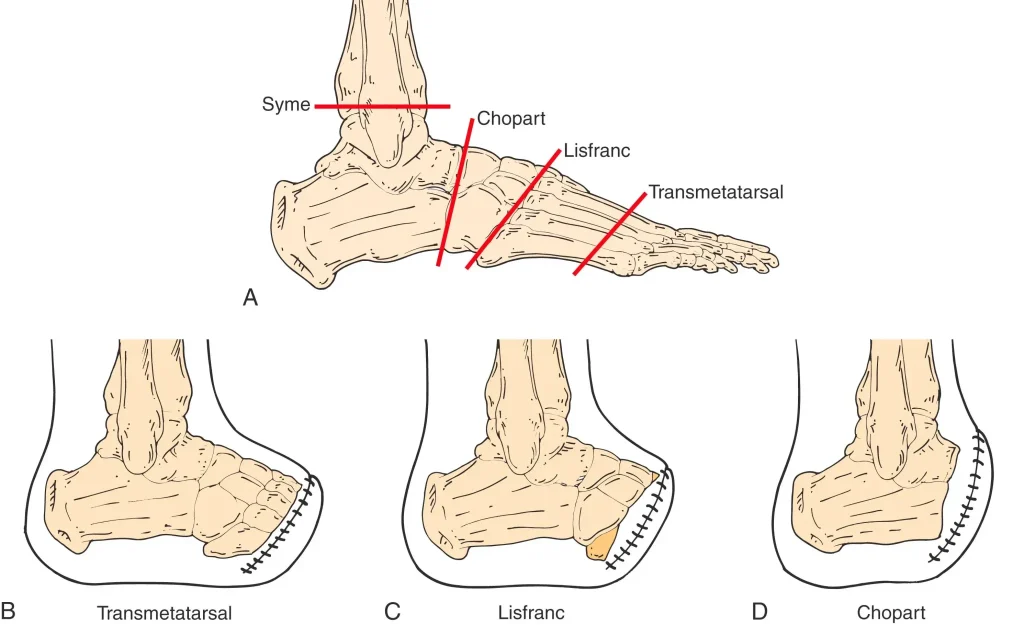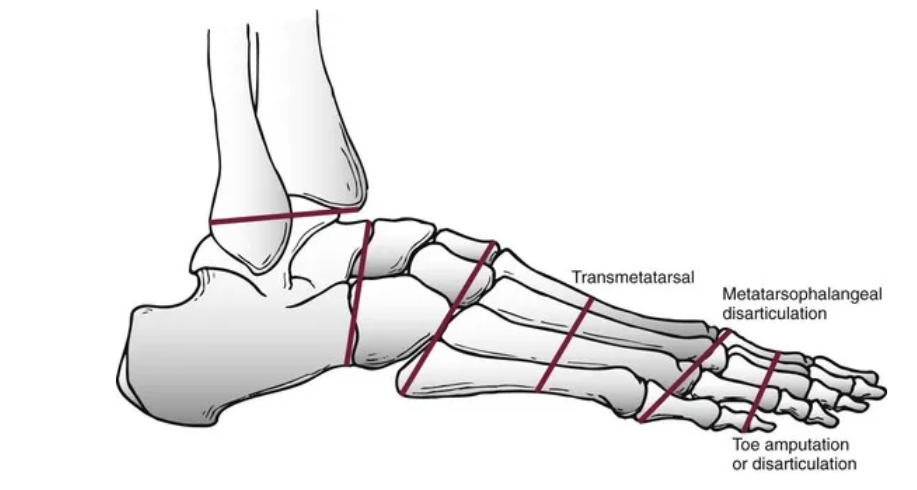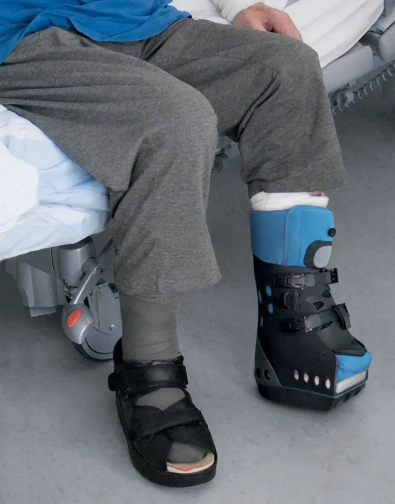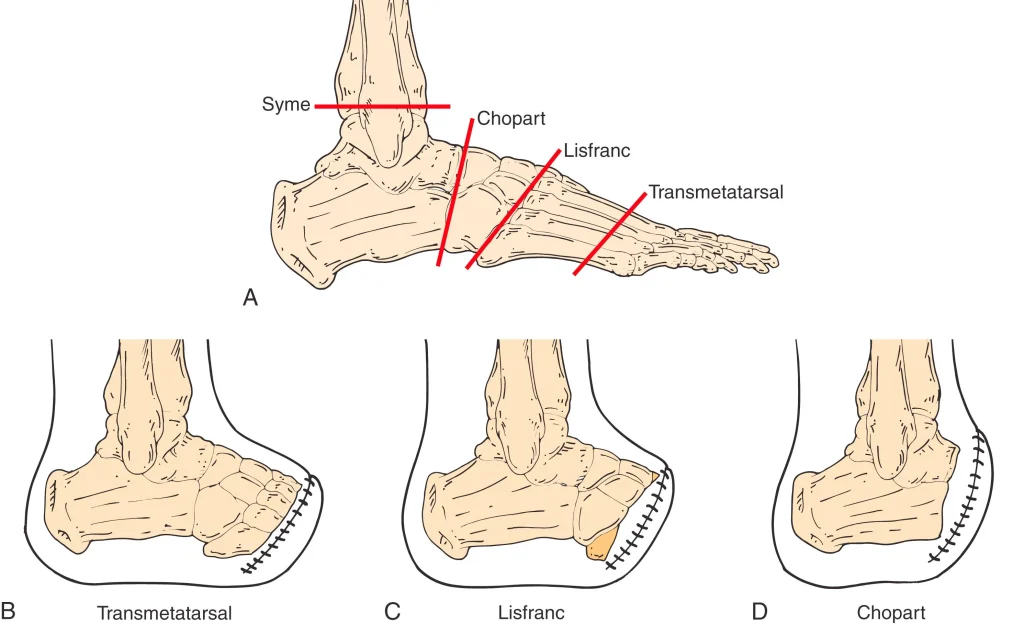
Foot diseases, injuries or infections often lead to partial or complete foot amputations inevitably. Lisfranc amputation and the Chopart amputation are two surgical procedures that surgically remove the damaged or diseased part; however, the procedures are entirely different, with varying outcomes and prosthetic requirements.
In this blog, we will provide details about both procedures to help patients facing trauma, vascular issues, or diabetic foot amputation types in making informed decisions about treatment procedures.
What Is a Lisfranc Amputation?
A Lisfranc amputation is a partial foot surgery. It is performed at the Lisfranc joint, where the long bones of the foot (metatarsals) join with the small bones in the middle of the foot (tarsal bones).
This procedure removes the toes and the metatarsals, while preserving the heel and ankle. Therefore, patients can still put weight on the foot and maintain better balance and stability compared to other procedures.
Lisfranc Amputation Main Causes
This surgery is often recommended when:
- Severe trauma damages the front of the foot.
- Severe diabetic foot infections do not heal or improve with treatments.
- Circulatory problems lead to tissue death in the forefoot.
- Forefoot tumours require surgical removal.
Benefits of Lisfranc Amputation
- Preserves natural heel and ankle function.
- Allows for improved balance and gait.
- Easier to fit with a prosthesis.
- Less energy is required for walking compared to higher amputations.
Prosthetic Solutions in Lisfranc Amputation
Prosthesis for Lisfranc amputation are specially designed to restore the missing forefoot and provide push-off power while walking. Prosthetic options may include:
- Custom shoe inserts for support and comfort.
- Partial foot prosthesis to restore alignment.
- Prosthetics for active users who need more energy return.
At KARE Prosthetics & Orthotics, prostheses are designed using advanced lightweight materials that ensure durability, stability, and comfort for daily life.
Recovery After Lisfranc Amputation
Recovery involves three stages:
- 6–8 weeks of healing: The primary focus is on wound care and preventing infection at all costs.
- 2–3 months of Rehabilitation: Monitored physical therapy to strengthen the residual foot and improve balance.
- Prosthetic Fitting: After healing, a customised Lisfranc prosthesis is made for mobility and daily use.
A Lisfranc amputation is considered a more functional option since it preserves more of the foot compared to a Chopart Amputation procedure.
What Is a Chopart Amputation?

A Chopart amputation is a partial foot amputation procedure, performed at the midtarsal joint to remove the damaged forefoot, midfoot, keeping the heel bone and ankle.
Chopart Amputation Causes
- Severe trauma where Lisfranc-level amputation is not possible.
- Extensive diabetic infections spreading beyond the forefoot.
- Malignant tumours in the midfoot.
Disadvantages of Chopart Amputation
- Reduced push-off power while walking.
- Increased risk of downward pointing of the foot.
- Requires more complex prosthetic support than a Lisfranc injury.
Chopart Amputation Prosthesis
Patients usually require a prosthesis that stabilises the ankle and hindfoot, preventing deformity and enabling smoother walking.
Key Differences: Lisfranc Amputation vs Chopart Amputation
| Feature | Lisfranc Amputation | Chopart Amputation |
| Level | Tarsometatarsal joint (forefoot removal) | Midtarsal joint (forefoot + midfoot removal) |
| Stability | More stable, preserves heel + ankle | Less stable, higher deformity risk |
| Mobility | Easier prosthetic fitting, better gait | Reduced push-off, harder rehab |
| Prosthesis | Lisfranc prosthesis with shoe support | Advanced prosthesis for hindfoot stability |
Lisfranc amputation preserves more of the natural foot, resulting in better mobility outcomes, while Chopart amputation is more extensive and requires more advanced prosthetic solutions.
Other Diabetic Foot Amputation Types
Both Lisfranc and Chopart procedures fall under the broader category of diabetic foot amputation types, which include:
- Toe Amputation: Removes one or more than one toe.
- Ray Amputation: Removal of the toe plus metatarsal.
- Lisfranc Amputation: At the tarsometatarsal joint.
- Chopart Amputation: At the midtarsal joint.
- Syme’s or Below-Knee Amputation: When infection spreads beyond salvage.
Understanding these helps patients anticipate treatment outcomes and plan for prosthetic care.

Why Choose KARE Prosthetics & Orthotics for Prosthetic Foots?
At KARE Prosthetics & Orthotics, we believe every patient deserves personalised care and the highest quality prosthetic solutions. What sets us apart is our commitment to combining advanced technology with compassionate, patient-centred service.
- Custom Solutions: We design and manufacture prosthetic devices tailored to each individual, ensuring optimal comfort, function, and confidence.
- Advanced Technology: From CAD/CAM systems to microprocessor-controlled components, we utilise the latest innovations to deliver precise and reliable results.
- Comprehensive Care: Our process starts with a detailed consultation and continues through evaluation, treatment, fitting, education, and rehabilitation.
- Expert Team: Our skilled practitioners focus on designing and fitting prosthetics that restore mobility and independence.
- Ongoing Research & Education: We continually improve our services through research, training, and the adoption of new prosthetic advancements.
Frequently Asked Questions
1. How much time does it take to recover from a Lisfranc surgery?
Recovery may take 3–6 months and includes healing, physiotherapy, and adaptation to prosthetics.
2. How to strengthen the foot after Lisfranc surgery?
You must follow all guidelines for rehabilitation, including resistance training, balance exercises, and stretching, as guided by a physiotherapist.
3. Can I walk barefoot after Lisfranc surgery?
No, walking barefoot will increase pressure on the residual foot. Therefore, you must wear specialised footwear or prosthetics.
4. How much does Lisfranc surgery cost?
The cost of Lisfranc surgery may vary from hospital to hospital, depending on the surgeon and the type of prosthetic requirements. Therefore, you should expect the cost to range from moderate to high, with expenses for custom prosthetics.
5. What is the difference between Lisfranc and Chopart amputations?
Lisfranc amputation is a surgery that removes the forefoot, while Chopart amputation removes both forefoot and midfoot. Lisfranc preserves more of the foot, giving stability and allowing easier prosthetic fitting.
Conclusion
Lisfranc amputation does not have to change your way of life or activities. The advanced prosthetics available today take recovery much beyond healing to renewed independence, regaining mobility, and a new level of confidence.
The KARE Prosthetics & Orthotics team combines clinical insights with quality prosthetics to ensure their patients walk with renewed confidence.
Why let amputation hold you back? Book a free consultation with us and step towards a more active life.





